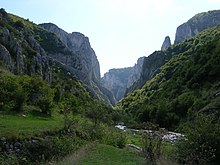
With an area of 238,397 km2 (92,046 sq mi), Romania is the twelfth-largest country in Europe. It is a country located at the crossroads of Eastern and Southeast Europe. It's bordered on the Black Sea, the country is halfway between the equator and the North Pole and equidistant from the westernmost part of Europe—the Atlantic Coast—and the most easterly—the Ural Mountains. Romania has 3,195 kilometres (1,985 mi) of border. Moldova and Ukraine lie to the east, Bulgaria to the south, and Serbia and Hungary to the west by the Pannonian Plain. In the southeast, 245 kilometres (152 mi) of sea coastline provide an important outlet to the Black Sea and the Atlantic Ocean.

The Danube Delta is the second largest river delta in Europe, after the Volga Delta, and is the best preserved on the continent. Occurring where the Danube River empties into the Black Sea, most of the Danube Delta lies in Romania, with a small part located in Ukraine. Its approximate surface area is 4,152 square kilometres, of which 3,446 km2 (1,331 sq mi) is in Romania. With the lagoons of Razim–Sinoe, located south of the main delta, the total area of the Danube Delta is 5,165 km2 (1,994 sq mi). The Razim–Sinoe lagoon complex is geologically and ecologically related to the delta proper; the combined territory is listed as a World Heritage Site.

The Retezat National Park is a protected area located in the Retezat Mountains in Hunedoara county, Romania. Founded in 1935, it is the oldest national park in the country and categorized as a category II IUCN national park.
Wildcrafting is the practice of harvesting plants from their natural, or 'wild' habitat, primarily for food or medicinal purposes. It applies to uncultivated plants wherever they may be found, and is not necessarily limited to wilderness areas. Ethical considerations are often involved, such as protecting endangered species, potential for depletion of commonly held resources, and in the context of private property, preventing theft of valuable plants, for example, ginseng.
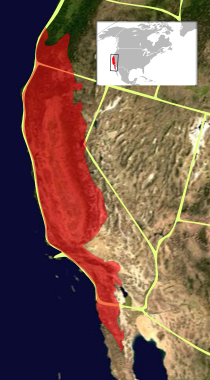
The California Floristic Province (CFP) is a floristic province with a Mediterranean-type climate located on the Pacific Coast of North America with a distinctive flora similar to other regions with a winter rainfall and summer drought climate like the Mediterranean Basin. This biodiversity hotspot is known for being the home of the Sierran giant sequoia tree and its close relative the coast redwood. In 1996, the Province was designated as a biodiversity hotspot allowing it to join ranks among 33 other areas in the world with many endemic species. To be named a biodiversity hotspot, an area has to contain species and plant life that cannot be found anywhere else in the world. The California Floristic Province is home to over 3,000 species of vascular plants, 60% of which are endemic to the province.
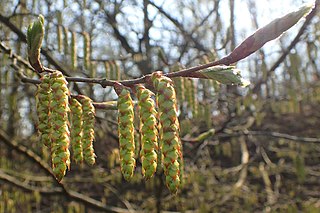
The Flora of Lithuania is estimated to comprise about 10,600 species. About 1,350 of these are vascular plants; about 335 are bryophytes; and about 2,000 are algae. Lichens are represented by about 500 species, and fungi by about 6,400 species. About 550 of these species are considered extinct or threatened. Protected areas now cover more than 12% of the territory of Lithuania.

The Danube crested newt or Danube newt is a species of newt found in central and eastern Europe, along the basin of the Danube river and some of its tributaries and in the Dnieper delta. It has a smaller and more slender body than the other crested newts in genus Triturus but like these, males develop a conspicuous jagged seam on back and tail during breeding season.

The Hyrcanian forests are a zone of lush lowland and montane forests covering about 55,000 square kilometres (21,000 sq mi) near the shores of the Caspian Sea in Iran and Azerbaijan. The forest is named after the ancient region of Hyrcania. The World Wide Fund for Nature refers to the ecoregion as the Caspian Hyrcanian mixed forests. Since 5 July 2019, the Hyrcanian Forests have been designated a UNESCO World Heritage Site. In September 2023, the heritage site expanded to incorporate portions of the forest located in Azerbaijan.
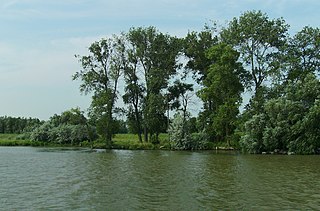
Letea Forest is the oldest natural reservation in Romania. It was established in 1938, when the Romanian Council of Ministers passed Decision No. 645 declaring the forest a nature reserve. It is located between the Sulina and Chilia branches of Danube in the Danube Delta. It covers an area of approximately 2,825 ha or 6,980 acres or 28.25 km2.
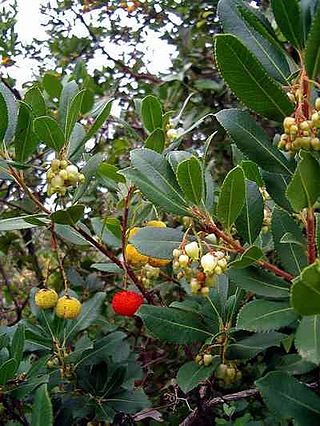
The flora of Italy is all the plant life present in the territory of the Italian Republic. The flora of Italy was traditionally estimated to comprise about 5,500 vascular plant species. However, as of 2019, 7,672 species are recorded in the second edition of the flora of Italy and in its digital archives Digital flora of Italy. In particular, 7,031 are autochthonous and 641 are non native species widely naturalized since more than three decades. Additionally, further 468 exotic species have been recorded as adventitious or naturalized in more recent times.
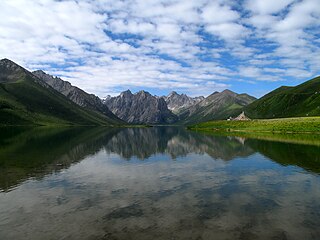
The flora of China consists of a diverse range of plant species including over 39,000 vascular plants, 27,000 species of fungi and 3000 species of bryophytes. More than 30,000 plant species are native to China, representing nearly one-eighth of the world's total plant species, including thousands found nowhere else on Earth. China's land, extending over 9.6 million km, contains a variety of ecosystems and climates for plants to grow in. Some of the main climates include shores, tropical and subtropical forests, deserts, elevated plateaus and mountains. The events of the continental drift and early Paleozoic Caledonian movement also play a part in creating climatic and geographical diversity resulting in high levels of endemic vascular flora. These landscapes provide different ecosystems and climates for plants to grow in, creating a wide variety of different flora spanning over not just China, but different parts of the world.

The national symbols of Hungary are flags, icons or cultural expressions that are emblematic, representative or otherwise characteristic of Hungary or Hungarian culture. The highly valued special Hungarian products and symbols are called Hungaricum or Hunnerisms.
The wildlife of Turkey is abundant and diverse. Turkey is a large country with many geographic and climatic regions and a great diversity of plants and animals, each suited to its own particular habitat. About 1,500 species of vertebrates and 19,000 species of invertebrates have been recorded in the country. Some of the world's staple crops were first cultivated in this area and many of their wild relatives are still found here. The country acts as a crossroads for many birds during migration, connecting Europe, Asia, and the Near East.

Many areas of Vietnam are under protection. While the national reserves cover small areas of scientific significance with restricted access, the national parks also cover wetlands of Ramsar designated areas and BirdLife International inscribed bird areas. The largest of the national parks initially covered were the Cúc Phương National Park, the Cát Tiên National Park, and the Côn Đảo National Park which to start with were forest areas cum reserves or prohibited areas. The objective for creating national parks was to allow access to the reserved areas as a part of ecotourism and cultural needs with full attention to the basic approach of conservation of natural environmental resources.

The wildlife of Ukraine consists of its diverse fauna, flora and funga. The reported fauna consists of 45,000 species when including the areas of the Black Sea and the Sea of Azov. Ukraine's protected environments consist of 33 Ramsar sites covering an area of 7,446.51 square kilometres (2,875.11 sq mi). Biosphere nature reserves and three national parks are all part of the GEF projects portfolio of conservation of biodiversity in the Danube Delta. Their vegetation pattern is mixed forest area, forest-steppe area, steppe area, Ukrainian Carpathian Mountains and Crimean Mountains. Some of the protected areas that were reserves or parks are subsumed under the biosphere reserves.
The Satchinez swamps, nicknamed the Banat delta, form an ornithological reserve that spreads over 1,194 ha near Satchinez, in Timiș County, Romania. It was founded in 1942, at the proposal of the Romanian ornithologist Dionisie Linția. The Satchinez swamps concentrate 40% of Romania's avifauna, being the second most important after the Danube Delta.

Privolzhskaya Lesostep Nature Reserve is a Russian zapovednik situated in the watershed midway between the Volga River and the Don River. The reserve is divided into 5 sectors, all in the western part of the Volga Uplands. Three of the sectors are steppe terrain, and two are forests. Rivers with upper reaches in the reserve flow into both the Don and the Volga. Administratively, the reserve is situated in the Kuznetsky District of Penza Oblast. The reserve was formally established in 1989 with the stated purpose of protecting representative habitat of the northern steppes, and the transition zone from steppe to forest. Some sections of the reserve, however, have been protected since 1919. In all, the reserve sectors cover an area of 8,373 ha (32.33 sq mi), and has additional buffer zones out to 1 km from the reserve borders.

The fauna of Romania comprises all the animal species inhabiting the country of Romania and its coastal territory in the Black Sea.

The Pannonian mixed forests is a temperate broadleaf and mixed forests ecoregion in Europe. It covers an area of 307,720 km2 in all of Hungary, most of Slovakia, about half of Croatia and Slovenia, around a third of Bosnia and Herzegovina, Romania, and Serbia, and minor parts of Austria, Czech Republic, and Ukraine.

Rivnenskyi Nature Reserve is a strict nature reserve in the northwest of Ukraine, created to protect and study the representative landscape of the Polesia region. It was established by the President of Ukraine, Leonid Danylovych Kuchma, on April 3, 1999. In accordance with the Resolution of the Cabinet of Ministers of Ukraine on August 14, 2003, the reserve was permanently transferred to a land area of 42,288 km2.

